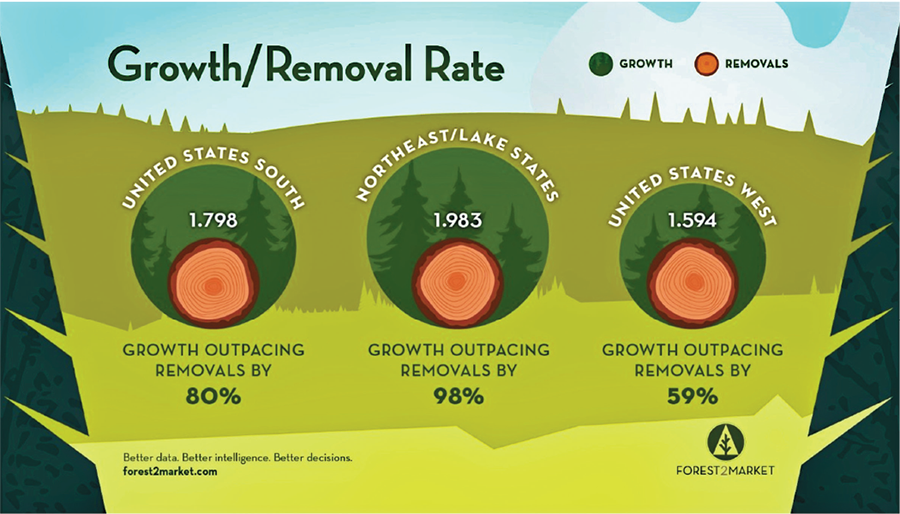
The global forest supply chain has had some long-overdue time in the media spotlight over the last couple of years. Every subject from “lumber prices” to “TP shortages” to “carbon sinks” and “renewable energy” is piquing public interest. While there is plenty of misinformation permeating the discussions, the fact that there is genuine interest in these topics is ultimately a good thing for forest landowners, wood products manufacturers, pulp and paper producers, and anyone participating in the forest value chain.
How do these topics relate to the broader discussion about climate change? To get an accurate idea of how forests—and the management of working forests—impact terrestrial carbon levels that help mitigate the effects of climate change, we first must understand the primary driver of global carbon emissions: energy.
Americans, in particular, use an incredible amount of energy, which drives the on-demand economy we have grown accustomed to. The COVID-19 pandemic and associated lockdown measures drove primary global energy consumption down to 556.63 exajoules, which is in line with 2016 levels. However, while the US comprises just over 4 percent of total global population, we consumed nearly 88 exajoules in 2020—about 16 percent of total world primary energy consumption.
We largely use energy for two purposes: transportation and electricity. We generate this energy through various means, including solar, wind, hydropower, wave power, and thermal (geothermal, nuclear, and the combustion of carbon chains). Of these energy sources, only the combustion of carbon chains produces carbon emissions.
Let’s consider two important points about energy use and carbon:
- There are only two sources of carbon: below-ground, sequestered fossil carbon (e.g., crude oil, natural gas, etc.), and above-ground biological carbon (e.g., biomass). When sequestered fossil sources are combusted, the carbon is emitted and added to the atmospheric carbon level, which is the primary source of greenhouse gases (GHG) that contribute to climate change. Currently, 65 percent of US electricity is generated using fossil carbon sources (coal and natural gas), and almost 100 percent of our transportation fuels are derived from fossil carbon.
- When we burn (oxidize) one of these fuel sources, the process breaks the chemical bond between the carbon and oxygen atoms, resulting in the release of thermal energy. Due to their chemical makeup, fossil fuels are more “efficient” in that there is more energy generated per unit of mass burned compared to other fuel sources. Yet ALL of the fossil carbon is emitted as net carbon in addition to the atmosphere (taking carbon that was sequestered below the ground and adding it into the atmosphere).
HOW DO US FORESTS HELP “CAPTURE” THIS CARBON?
Forest ecosystems make up the largest terrestrial carbon sink on Earth. Trees draw carbon dioxide from the atmosphere through photosynthesis, and every part of a tree—trunks, branches, leaves, and roots—stores carbon. By weight, dried tree material is about 50 percent carbon. As part of the lifecycle of trees, they also release carbon dioxide back into the atmosphere when they decompose after death or burn during fires. At a landscape level, the US Forest Service notes that the amount of carbon sequestered in forests closely mirrors the natural cycle of tree growth and mortality.
Per recent data published by the Proceedings of the National Academy of Sciences (PNAS) and Forest Resources Association (FRA), there are approximately 1.4 trillion live trees across all age/size classes on more than 635 million acres of forestland in the continental US.
- Collectively, there are an estimated 71,808 million metric tons (MMT) of carbon dioxide (CO2) stored in these live trees.
- US forest carbon stocks have increased by 11 percent from 1990 to 2019.
- Average carbon density in aboveground trees across US forests is 22.6 tons per acre.
- Across the US, forests, urban trees, and harvested wood products:
- Remove 14 percent of all CO2 emissions.
- Store the equivalent of 33 years of all CO2 emissions produced across the US.
WHAT ABOUT DEFORESTATION?
The reality is that large-scale deforestation is simply not happening in the US. According to the USDA, from 1953 to 2011, in a time of expanding population and increasing demand for solid wood products, paper products, and energy, the total volume of trees grown across the US increased by 50 percent. Due to innovations in silvicultural management techniques, private forest owners are currently growing 43 percent more wood than they remove from their timberlands.
A 2017 Forest2Market statistical analysis for a 70-year period showed that increases in tree removals are associated with more timberland acres, better growth, and larger inventories. Over the last 70+ years, annual tree removals throughout the South increased 57 percent from 5.5 to 8.7 billion cubic feet. Simultaneously, annual growth increased 112 percent from 6.8 to 14.4 billion cubic feet. The amount of timberland in the US South has also remained stable, increasing by about 3 percent. Because annual growth has outpaced annual removals by an average of 38 percent, inventory increased 108 percent from 142.1 to 296.1 billion cubic feet.
HOW DO WE KNOW AMERICA’S FORESTS ARE NOT BEING PERMANENTLY DESTROYED?
The most precise way to gauge the balance of tree growth and removals is to analyze an area’s growth-to-removal ratio (GRR). As an indicator of the trajectory of available supply over time (not a snapshot of availability at a moment in time), a GRR calculation quantifies overall forest sustainability.
A value of 1.0 suggests growth and removals are in balance; a value greater than 1.0 means forest inventory growth is outpacing removals (greater sustainability); and a value lower than 1.0 means removals are outpacing growth (lower sustainability). For example, a GRR of 1.33 means that growth is outpacing removals by 33 percent, whereas a GRR of 0.95 means that removals are outpacing growth by 5 percent.
Adjusting for land-use changes, studies have shown GRR in a region tends to be cyclical over long periods of time as market forces react to high or low ratios that then move back toward equilibrium. Per the most recent data via the USFS (see graphic), America’s forested regions have an excess of available supply.
- US South: 1.798 (tree growth is outpacing removals by 80 percent)
- Eastern North America: 1.983 (tree growth is outpacing removals by 98 percent)
- Western North America: 1.594 (tree growth is outpacing removals by 59 percent)
Any decrease in demand for forest products could skew the balance between timber markets and forest resources. In fact, an ongoing trend in this direction could put a region’s forest resources at risk of being underutilized, as the growth of forest inventory continues to significantly outpace removals. When forest resources become chronically underutilized, one of two scenarios will likely occur:
- Land use changes become an attractive alternative and with such conversions, the forest will be lost forever. Urbanization adds pressure to regional forest resources and makes forest management increasingly difficult.
- Overcrowded, unhealthy forests become easy targets for disease and pest invasions, oftentimes resulting in large-scale tree mortality. These conditions then create an environment prone to destructive wildfires—like those experienced every summer in the Pacific Northwest—which release tons of captured carbon into the atmosphere and cause cascading damage to communities, other natural resources, and wildlife.
Wildfires have gotten so severe in the Western US that they are now on the agenda in Washington, DC, and some of the legislative proposals seem promising. But predictably, lawmakers can’t agree on the causes of today’s megafires, let alone the solutions. Is it climate change? Is it forest mismanagement? Framing this issue as an “either/or” choice does a disservice to us all when the real question is this: “What can we do now to mitigate further damage?”
One thing we can do now is reduce fuels through active forest management and the creation of new markets for low-value wood products. California alone has more than 130 million standing dead trees in its forests. With such a fuel load, fires are now hotter, larger, and more destructive than they would otherwise be. As a result, millions of acres of timberland now burn needlessly every year in western states, releasing millions of tons of contaminants and sequestered carbon into the atmosphere.
BENEFITS OF HEALTHY TIMBERLAND
Forest utilization and the manufacture of wood fiber-based products benefit society and the global environment in many ways: housing/building products, paper products, energy, textiles, chemicals, and myriad other products are derived from wood, which is one of our most valuable renewable resources. Healthy, working forests across the US provide immeasurable environmental and social benefits by:
- Delivering the valuable wood-based products we depend on
- Supporting 2.5 million jobs and US$109 billion in payroll
- Providing wildlife habitat
- Filtering our water
- Sequestering carbon
- Mitigating the impacts of climate change
Sustainable forest management regimes are key to making this environmental/economic relationship work so seamlessly. Timber, and the land the timber is on, are economic assets. As is the case with any commodity product, when there is a healthy market for their assets, landowners actively manage these assets to maximize economic return.
The private forest management system prevalent throughout many regions of the US is a great example of how markets can work to help address environmental concerns. Trees are planted, grown, harvested, and utilized—all while storing CO2—before the process begins again.
The most effective way to maximize CO2 sequestration is to sustainably harvest mature trees for conversion into wood-based products and replant the harvested acres with new, young trees that will benefit from accelerated growth and carbon storage. This has been the approach of the forest products industry for years and, due to its imparted climate benefits, should be standard procedure going forward.
If we really want to maximize CO2 sequestration in our forests—the most advanced carbon-capture devices in the world—we need to keep harvesting, utilizing, and planting more trees.
 Paper 360
Paper 360

